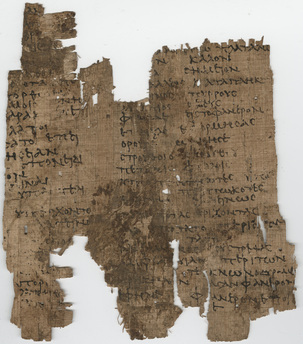 P.Oxy. 67.4633
P.Oxy. 67.4633 P.Oxy. 67.4633 was once a beautiful scroll containing scholia (a kind of ancient commentary) to Homer's Iliad (see image at left). This third century C.E. papyrus was discovered among the trash mounds at the ancient Egyptian city of Oxyrhynchus. The papyrus sheet preserves two columns of text written in a nice hand.
But this papyrus' ultimate fate was downright shitty—literally. Joseph Spooner, the papyrus' editor, stated that "the papyrus subsequently suffered an ignominious fate, as a piece of toilet paper" (87). That's right: this beautiful papyrus was last used as toilet paper, or what AnneMarie Luijendijk has called, "toilet papyrus" (246). The brown lumps of organic material were, according to Spooner, "examined by an archaeobotanist at the Institute of Archaeology, London, and were found to contain wheat husks" (87). So, the color and organic composition of these lumps suggest that someone used this Homeric papyrus for their bathroom duties.
One might wonder: do these remnants still smell like...you know? One thing we do know is that the papyrus in the image above was not found in that form. It was found folded and crumbled together, like almost every other papyrus found in the trash heaps of Oxyrhynchus. To flatten a dry lump of papyrus, one has to apply moisture to it to relax its fibers. Then, the papyrus can be flattened. According to Luijkendijk, "Whether it was the vapors let loose when this Homer piece was dampened or more substantial organic remains stuck to it, the conservation of that papyrus must have been a surprisingly unpleasant task" (246). So not only do we have a dirty papyrus, we also probably have a stinky one! Homer's Iliad was an extremely popular text in the ancient world. So perhaps this fragment was luxury toilet paper, the Charmin of the ancient world.
But all jokes aside, this papyrus prompts many questions about discarded texts in antiquity. Why were texts thrown to the dump? Who threw them away? Were they damaged or worn out and thus no longer useful? Did the "operator" of this papyrus know what text he/she was using for his/her gluteus maximus? Was this papyrus used at home or outside by the rubbish dump (no pun intended), after the papyrus had already been disposed of? This piece generates some interesting sociological questions, and while we may not know the answers to most of them, we can be sure that Homer became very useful for some ancient person at a very pressing time!
References
Luijendijk, AnneMarie. "Sacred Scriptures as Trash: Biblical Papyri from Oxyrhynchus." Vigiliae Christianae 64 (2010): 217-254.
Spooner, Joseph. Nine Homeric Papyri from Oxyrhynchus (Florence, 2002).
But this papyrus' ultimate fate was downright shitty—literally. Joseph Spooner, the papyrus' editor, stated that "the papyrus subsequently suffered an ignominious fate, as a piece of toilet paper" (87). That's right: this beautiful papyrus was last used as toilet paper, or what AnneMarie Luijendijk has called, "toilet papyrus" (246). The brown lumps of organic material were, according to Spooner, "examined by an archaeobotanist at the Institute of Archaeology, London, and were found to contain wheat husks" (87). So, the color and organic composition of these lumps suggest that someone used this Homeric papyrus for their bathroom duties.
One might wonder: do these remnants still smell like...you know? One thing we do know is that the papyrus in the image above was not found in that form. It was found folded and crumbled together, like almost every other papyrus found in the trash heaps of Oxyrhynchus. To flatten a dry lump of papyrus, one has to apply moisture to it to relax its fibers. Then, the papyrus can be flattened. According to Luijkendijk, "Whether it was the vapors let loose when this Homer piece was dampened or more substantial organic remains stuck to it, the conservation of that papyrus must have been a surprisingly unpleasant task" (246). So not only do we have a dirty papyrus, we also probably have a stinky one! Homer's Iliad was an extremely popular text in the ancient world. So perhaps this fragment was luxury toilet paper, the Charmin of the ancient world.
But all jokes aside, this papyrus prompts many questions about discarded texts in antiquity. Why were texts thrown to the dump? Who threw them away? Were they damaged or worn out and thus no longer useful? Did the "operator" of this papyrus know what text he/she was using for his/her gluteus maximus? Was this papyrus used at home or outside by the rubbish dump (no pun intended), after the papyrus had already been disposed of? This piece generates some interesting sociological questions, and while we may not know the answers to most of them, we can be sure that Homer became very useful for some ancient person at a very pressing time!
References
Luijendijk, AnneMarie. "Sacred Scriptures as Trash: Biblical Papyri from Oxyrhynchus." Vigiliae Christianae 64 (2010): 217-254.
Spooner, Joseph. Nine Homeric Papyri from Oxyrhynchus (Florence, 2002).

